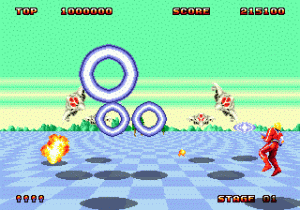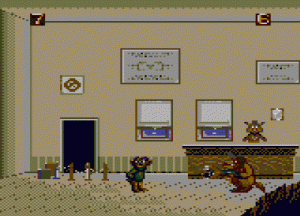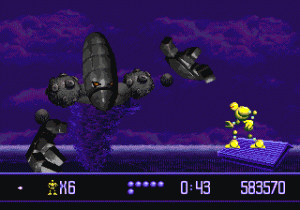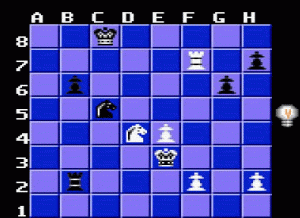Spring is here, and winter’s icy grip is finally thawing out. Through it all, our games have been there to keep our minds off the weather, and we can always rely on them to be a wonderful distraction. This month’s selection is a great assortment, and our readers are sure to find something they love or need to play. Read on and see!
Space Harrier II By Ken Horowitz
 Here’s a game that doesn’t get enough credit. Many deride the scrolling and easy gameplay, but I don’t think those are bad enough to warrant dismissing the game entirely. There’s something about the atmosphere (love the music!) and designs that make me partial to Space Harrier II, and the gameplay is smooth enough to make the game more than playable. The original game set a very high bar, and I agree that the Genesis sequel doesn’t quite get there. It does a fair job though, and it manages to retain much of what made its predecessor so much fun. Sure, the scaling may not be the best, but I’m willing to overlook that since this was an early release. Simply put, I think that Space Harrier II is a better game than most people believe.
Here’s a game that doesn’t get enough credit. Many deride the scrolling and easy gameplay, but I don’t think those are bad enough to warrant dismissing the game entirely. There’s something about the atmosphere (love the music!) and designs that make me partial to Space Harrier II, and the gameplay is smooth enough to make the game more than playable. The original game set a very high bar, and I agree that the Genesis sequel doesn’t quite get there. It does a fair job though, and it manages to retain much of what made its predecessor so much fun. Sure, the scaling may not be the best, but I’m willing to overlook that since this was an early release. Simply put, I think that Space Harrier II is a better game than most people believe.
TaleSpin (Game Gear) By David Dyne
 Most people seem to agree that TaleSpin on the Genesis can be a frustrating game due to a plethora of reasons including cheap hits, annoying boss fights, and the boneheaded AI that flies the Sea Duck plane into every obstacle imaginable when you’re playing as Kit instead of Baloo. That’s not the case for the Game Gear port. You’ll be in a much easier time with this version despite no difficulty settings, and if you do select Kit, he files the Sea Duck instead of being tethered to the back to be bombed and strafed to death like his sixteen bit counterpart. I wonder if the developers of the Game Gear version saw how difficult the Genesis version was and decided to tone it down, or they simply wanted a more accessible game on a handheld platform. Either way, it’s an enjoyable romp with some great eight bit renditions of the Genesis soundtrack and a bit of slowdown here and there. Next month I plan on tackling the Genesis version again to see if it’s worth all the hassle to play through. Until then!
Most people seem to agree that TaleSpin on the Genesis can be a frustrating game due to a plethora of reasons including cheap hits, annoying boss fights, and the boneheaded AI that flies the Sea Duck plane into every obstacle imaginable when you’re playing as Kit instead of Baloo. That’s not the case for the Game Gear port. You’ll be in a much easier time with this version despite no difficulty settings, and if you do select Kit, he files the Sea Duck instead of being tethered to the back to be bombed and strafed to death like his sixteen bit counterpart. I wonder if the developers of the Game Gear version saw how difficult the Genesis version was and decided to tone it down, or they simply wanted a more accessible game on a handheld platform. Either way, it’s an enjoyable romp with some great eight bit renditions of the Genesis soundtrack and a bit of slowdown here and there. Next month I plan on tackling the Genesis version again to see if it’s worth all the hassle to play through. Until then!
VectorMan By Colton Ray
 I got the urge to play through this amazing platformer again and it just wows me every time. I know its a cliche by now to talk about how a certain game “pushed the system to its limits,” but the intricate backgrounds and smooth scrolling of VectorMan truly utilize every ounce of the Genesis’ power. The Arctic Ridge level deserves to go down as one of the most beautiful 16-bit levels in video game history, with the lens flare Sun glittering of the ice and the frozen waterfall dripping onto machinery. The game truly does present a world that humans have left behind – it is cold, dangerous, and full of soulless machines. The sense of solitude and ennui really shines through in certain levels. Levels are also widely varied, matching to VectorMan’s morphing abilities. You journey from abandoned airports to ice caverns to Greek ruins and even a claustrophobic film studio before facing down Warhead in the midst of a swirling tornado. As a kid, I never made it past the first stage plane boss (I was terrible at games) and so was never privy to the awesome journey VectorMan takes to save the planet. VectorMan is a classic and is still just as much fun as it was back in 1995.
I got the urge to play through this amazing platformer again and it just wows me every time. I know its a cliche by now to talk about how a certain game “pushed the system to its limits,” but the intricate backgrounds and smooth scrolling of VectorMan truly utilize every ounce of the Genesis’ power. The Arctic Ridge level deserves to go down as one of the most beautiful 16-bit levels in video game history, with the lens flare Sun glittering of the ice and the frozen waterfall dripping onto machinery. The game truly does present a world that humans have left behind – it is cold, dangerous, and full of soulless machines. The sense of solitude and ennui really shines through in certain levels. Levels are also widely varied, matching to VectorMan’s morphing abilities. You journey from abandoned airports to ice caverns to Greek ruins and even a claustrophobic film studio before facing down Warhead in the midst of a swirling tornado. As a kid, I never made it past the first stage plane boss (I was terrible at games) and so was never privy to the awesome journey VectorMan takes to save the planet. VectorMan is a classic and is still just as much fun as it was back in 1995.
The Chessmaster By James Villone
My friend’s chess match has remained in limbo! I’ve already been using my repro of Chess to study our match a bit, with the result that it predicts stalemate, according to its best moves for both of us. This has not helped me find a winning solution (unless I just settle on stalemate, and consider it a mutual win). I decided to visit The Chessmaster for a cup of coffee. He’s not as smart as my Genesis cartridge Chess (from 1998), but the old man is still pretty-good at chess, and he was willing to mess around with my suspended arrangement, to see if we could make some more sense of it.
I’m a big fan of the Game Gear itself, with its ergonomic smoothness and weight. I find it very comfortable in my hands, so it’s a nice way to practice chess once in a while. Plus, The Chessmaster does play pretty well; he’s probably about as smart as was possible on Game Gear in 1990, and his imperfect skills make him resemble playing against a human, who makes a bad move now and then for us to take advantage of.
The Chessmaster is not someone to ask advice from, because his hints just point out possible moves, not necessarily good moves (in contrast, Chess offers hints that are actually helpful and educational). Thankfully, the old man plays better than he gives out advice. I set up our suspended match, as we can see in the screen-shot. It’s my friend’s turn to move, as black.
Experimenting with our match (including use of the rush function), The Chessmaster gave me the impression that the solution is simple: If I just push my pawn forward for each turn, he’ll soon reach the edge and retrieve my Queen, who will then give me an easy victory. It seemed I had finally found the solution, after all these weeks! It must have been too simple for me to realize it, since I was always trying to find elaborate moves with my knight and rook!
 It was exciting to finally solve this match, but I still had to confirm whether this strategy really works, beyond The Chessmaster’s apartment. Once I came home, I fired up 16-bit Chess; I was surprised that this simple strategy did actually work, on max-difficulty (with the rush function). Everything was encouraging, but I still had to test it on real maximum-difficulty, which means letting my Genesis think for as long as it wants to (thankfully, this is still not a long time; most moves take five minutes at most).
It was exciting to finally solve this match, but I still had to confirm whether this strategy really works, beyond The Chessmaster’s apartment. Once I came home, I fired up 16-bit Chess; I was surprised that this simple strategy did actually work, on max-difficulty (with the rush function). Everything was encouraging, but I still had to test it on real maximum-difficulty, which means letting my Genesis think for as long as it wants to (thankfully, this is still not a long time; most moves take five minutes at most).
Now, Chess’ earlier assessment of the match predicted stalemate, which means there are no solutions possible, for either side to win. And so, if I could find a way to win, it would contradict that assessment, and undermine the credibility of its artificial-intelligence! I marched my pawn forward but my Genesis was thinking really hard, about 10 minutes per move, twice its normal max processing-time, and this alone validated the trickiness of this arrangement! From the deepest corners of its ROM, it pulled its best ideas, and managed to impress me with some rook-knight combinations that were aggressive, and halted my progress!
So far, the most success I’ve found for this match, playing Chess on genuine top-difficulty, is still just different forms of stalemate. So, this confirms Chess’ previous assessment, which validates its artificial-intelligence and performance. It’s interesting that that pawn-march seemed so effective in The Chessmaster’s living room, and it required the absolute top-difficulty of Chess (with unlimited processing-time) to reaffirm that the match is unwinnable. This might suggest that that pawn-march appears far more threatening and effective than it really is, so it might have the benefit of psyching-out my friend, when we finally wrap things up!
The Chessmaster is always nice to visit once in a while, and I appreciate that he lets me experiment with a specific set-up, like this. Doing so emphasizes his Takeback/Replay functions, which let me try different moves, and “rewind” when things don’t work out, so I can then look for better moves. Genesis Chess lacks this exact same functionality, but its functions are equivalent; I’m currently using Chess for the same process of trying moves, and rewinding back, if they don’t work. The big difference is that with Chess, we can’t rewind to the start of the match, and then just animate the moves forward, as we can with The Chessmaster; however, Chess features the whole match being recorded in proper notation, so we can review past moves by just reading them. Despite both titles working fine for reviewing moves, in different ways: The Chessmaster’s typical Takeback/Replay does have a certain pointless fun factor, to be able to screw around with the animations backwards and forwards, like a videotape.
I’ve noticed that smashing buttons during Takeback/Replay might actually confuse the old man, and he might set up the board wrong! For example, one of the kings might turn into a knight, or a pawn. The match will be broken and the old rake won’t even realize it! I’m not complaining, though; I find these glitches amusing, and we can play some nonsensical arrangements, that we might never see anywhere else! For example, the ancient game is based on two kings, but a glitch may let us fight against a leaderless army, in which case, there’s probably no way to win, since there’s no king to checkmate. I wonder if just capturing all his pieces would count as a win? Probably not. Thankfully, The Chessmaster never gets confused during normal gameplay, and that’s what really counts (he only gets confused when we’re button-mashing the Takeback/Replay).
An odd detail I noticed is that the cartridge label has an icon for “single-player,” while the in-game menu does offer a two-player mode. I wasn’t sure what to think of this at first, but if it’s not simply the wrong symbol, then “single-player” might refer to a lack of link-cable connectivity? (I don’t have a link-cable to check.) If that’s the case, then “two-player” mode would mean one Game Gear passed back-and-forth, like a bottle of wine. It would be a shame if it doesn’t actually work with two consoles linked together, with each screen showing that player’s view of the board, as I had always expected.
I also tried “two-player mode” with just my single Game Gear. Strangely, the view of the board stays the same, while the gameplay switches between both sides. This “two-player mode” might have actually been more intended for one person to practice chess alone, by controlling both sides, with an unchanging view of the board. (This means that on default settings: We make white’s moves from white’s perspective, but then we also make black’s moves, from white’s perspective.)
It’s kind of an interesting idea for practicing, though most folks would obviously rather see the proper view for each turn. (In comparison, 5-in-1 Funpak includes chess, clearly meant for two people to play on a single Game Gear passed back-and-forth; the screen’s perspective flips for each person’s turn.) The Chessmaster lets us manually flip the view of the board, of course, anytime we want; it just takes some cumbersome navigation through the menus. (So, one way or another, The Chessmaster is still two-player, if we really want it to be.)
Unfortunately, I’m guessing this cartridge probably doesn’t link-up with two Game Gears, and “two-player mode” resembles more of a single-player practice mode. I never would have thought of practicing chess by making all the moves for both sides, from only one side’s perspective – yet now I can imagine how it might help me learn to anticipate different attacks from my opponents.
Cheers to you, Chessmaster, chug some champagne, you clever old bastard – you’re still keeping me on my toes, and giving me new ideas, after all these years!

Recent Comments